Corporate Governance and Ethics in Tata Motors
VerifiedAdded on 2023/06/07
|12
|4266
|481
AI Summary
This report delves into the corporate governance and ethics of Tata Motors, including its internal and external mechanisms, failures and weaknesses, and the response of the company. It also explores the role of institutional investors, stakeholder and shareholder perspectives, and the impact of globalization on comparative analysis and corporate governance.
Contribute Materials
Your contribution can guide someone’s learning journey. Share your
documents today.
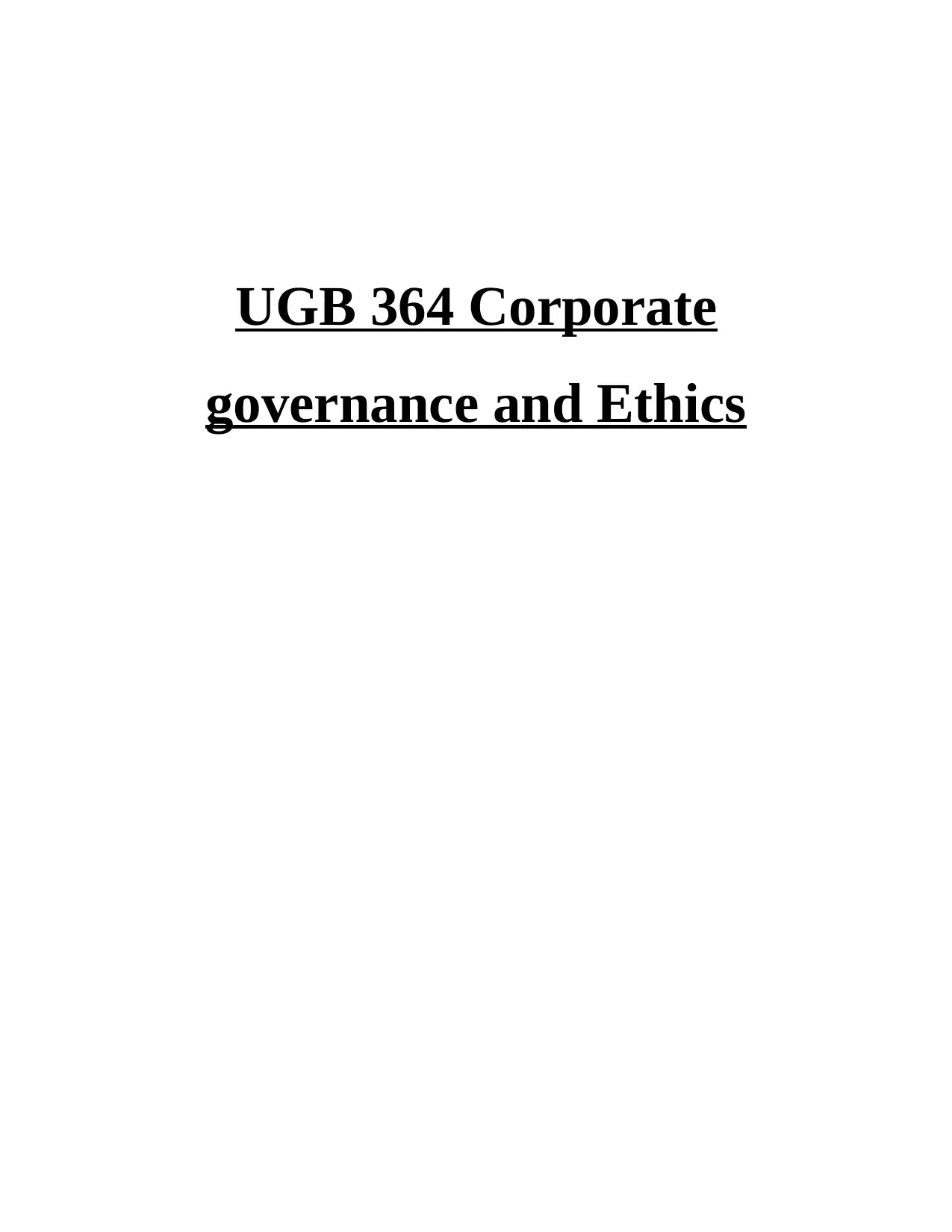
UGB 364 Corporate
governance and Ethics
governance and Ethics
Secure Best Marks with AI Grader
Need help grading? Try our AI Grader for instant feedback on your assignments.
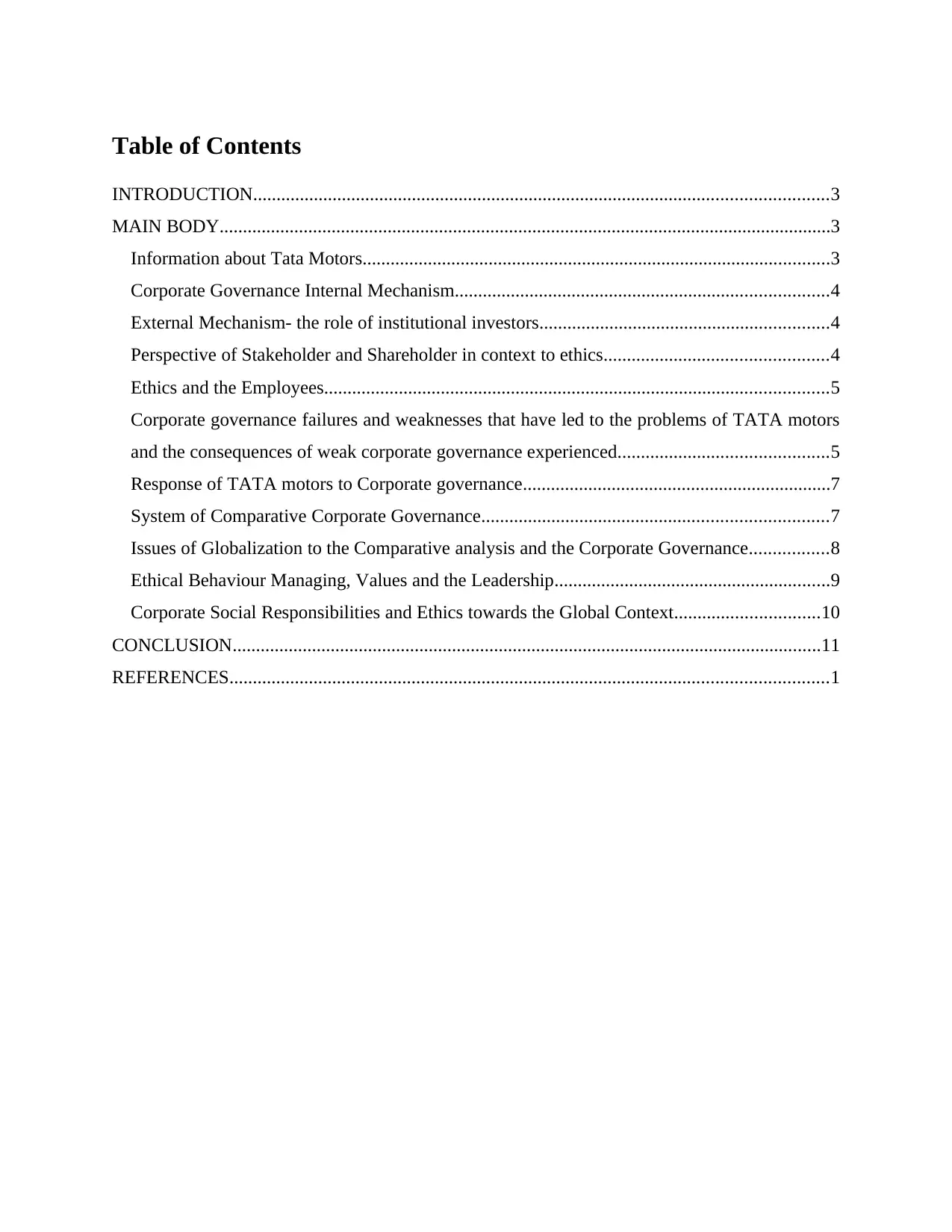
Table of Contents
INTRODUCTION...........................................................................................................................3
MAIN BODY...................................................................................................................................3
Information about Tata Motors....................................................................................................3
Corporate Governance Internal Mechanism................................................................................4
External Mechanism- the role of institutional investors..............................................................4
Perspective of Stakeholder and Shareholder in context to ethics................................................4
Ethics and the Employees............................................................................................................5
Corporate governance failures and weaknesses that have led to the problems of TATA motors
and the consequences of weak corporate governance experienced.............................................5
Response of TATA motors to Corporate governance..................................................................7
System of Comparative Corporate Governance..........................................................................7
Issues of Globalization to the Comparative analysis and the Corporate Governance.................8
Ethical Behaviour Managing, Values and the Leadership...........................................................9
Corporate Social Responsibilities and Ethics towards the Global Context...............................10
CONCLUSION..............................................................................................................................11
REFERENCES................................................................................................................................1
INTRODUCTION...........................................................................................................................3
MAIN BODY...................................................................................................................................3
Information about Tata Motors....................................................................................................3
Corporate Governance Internal Mechanism................................................................................4
External Mechanism- the role of institutional investors..............................................................4
Perspective of Stakeholder and Shareholder in context to ethics................................................4
Ethics and the Employees............................................................................................................5
Corporate governance failures and weaknesses that have led to the problems of TATA motors
and the consequences of weak corporate governance experienced.............................................5
Response of TATA motors to Corporate governance..................................................................7
System of Comparative Corporate Governance..........................................................................7
Issues of Globalization to the Comparative analysis and the Corporate Governance.................8
Ethical Behaviour Managing, Values and the Leadership...........................................................9
Corporate Social Responsibilities and Ethics towards the Global Context...............................10
CONCLUSION..............................................................................................................................11
REFERENCES................................................................................................................................1
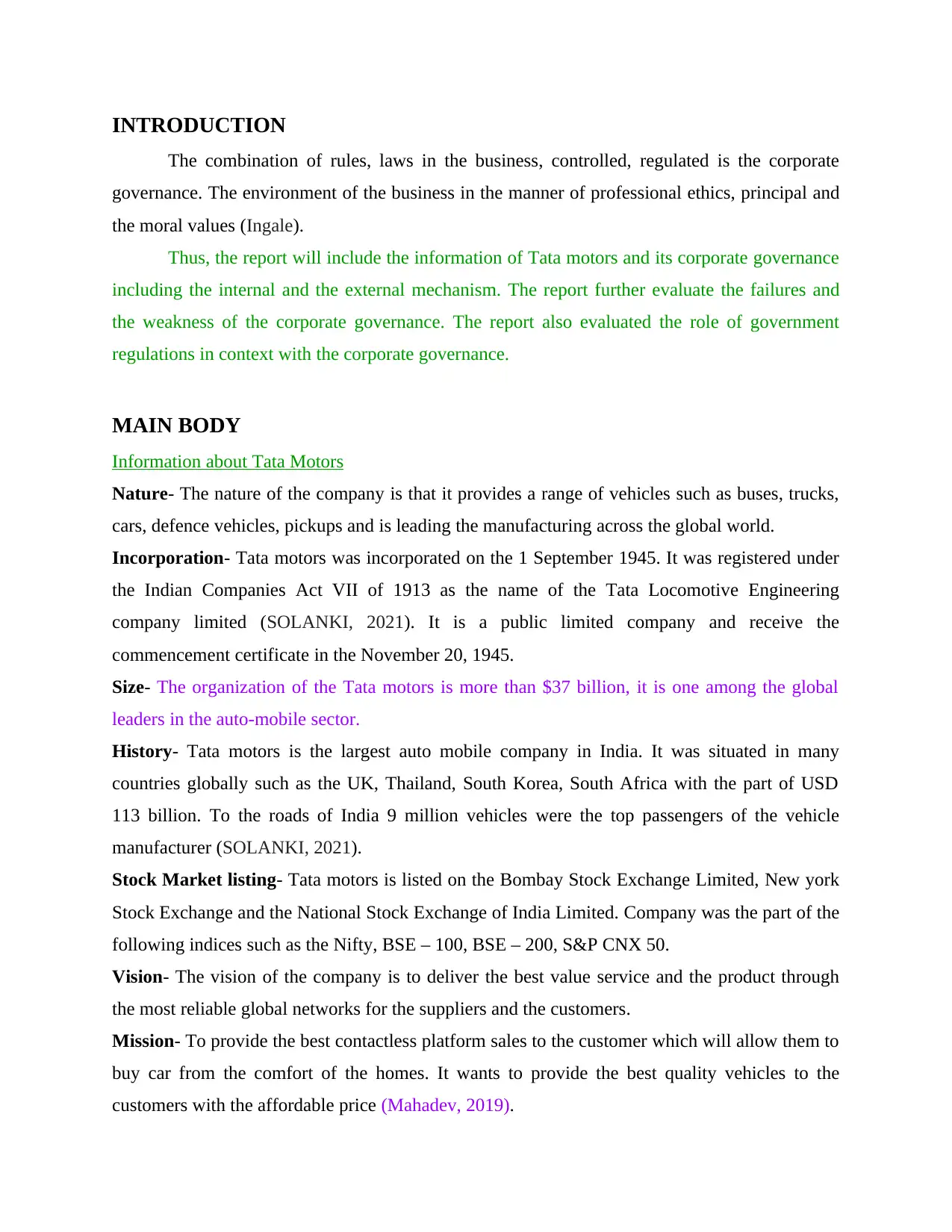
INTRODUCTION
The combination of rules, laws in the business, controlled, regulated is the corporate
governance. The environment of the business in the manner of professional ethics, principal and
the moral values (Ingale).
Thus, the report will include the information of Tata motors and its corporate governance
including the internal and the external mechanism. The report further evaluate the failures and
the weakness of the corporate governance. The report also evaluated the role of government
regulations in context with the corporate governance.
MAIN BODY
Information about Tata Motors
Nature- The nature of the company is that it provides a range of vehicles such as buses, trucks,
cars, defence vehicles, pickups and is leading the manufacturing across the global world.
Incorporation- Tata motors was incorporated on the 1 September 1945. It was registered under
the Indian Companies Act VII of 1913 as the name of the Tata Locomotive Engineering
company limited (SOLANKI, 2021). It is a public limited company and receive the
commencement certificate in the November 20, 1945.
Size- The organization of the Tata motors is more than $37 billion, it is one among the global
leaders in the auto-mobile sector.
History- Tata motors is the largest auto mobile company in India. It was situated in many
countries globally such as the UK, Thailand, South Korea, South Africa with the part of USD
113 billion. To the roads of India 9 million vehicles were the top passengers of the vehicle
manufacturer (SOLANKI, 2021).
Stock Market listing- Tata motors is listed on the Bombay Stock Exchange Limited, New york
Stock Exchange and the National Stock Exchange of India Limited. Company was the part of the
following indices such as the Nifty, BSE – 100, BSE – 200, S&P CNX 50.
Vision- The vision of the company is to deliver the best value service and the product through
the most reliable global networks for the suppliers and the customers.
Mission- To provide the best contactless platform sales to the customer which will allow them to
buy car from the comfort of the homes. It wants to provide the best quality vehicles to the
customers with the affordable price (Mahadev, 2019).
The combination of rules, laws in the business, controlled, regulated is the corporate
governance. The environment of the business in the manner of professional ethics, principal and
the moral values (Ingale).
Thus, the report will include the information of Tata motors and its corporate governance
including the internal and the external mechanism. The report further evaluate the failures and
the weakness of the corporate governance. The report also evaluated the role of government
regulations in context with the corporate governance.
MAIN BODY
Information about Tata Motors
Nature- The nature of the company is that it provides a range of vehicles such as buses, trucks,
cars, defence vehicles, pickups and is leading the manufacturing across the global world.
Incorporation- Tata motors was incorporated on the 1 September 1945. It was registered under
the Indian Companies Act VII of 1913 as the name of the Tata Locomotive Engineering
company limited (SOLANKI, 2021). It is a public limited company and receive the
commencement certificate in the November 20, 1945.
Size- The organization of the Tata motors is more than $37 billion, it is one among the global
leaders in the auto-mobile sector.
History- Tata motors is the largest auto mobile company in India. It was situated in many
countries globally such as the UK, Thailand, South Korea, South Africa with the part of USD
113 billion. To the roads of India 9 million vehicles were the top passengers of the vehicle
manufacturer (SOLANKI, 2021).
Stock Market listing- Tata motors is listed on the Bombay Stock Exchange Limited, New york
Stock Exchange and the National Stock Exchange of India Limited. Company was the part of the
following indices such as the Nifty, BSE – 100, BSE – 200, S&P CNX 50.
Vision- The vision of the company is to deliver the best value service and the product through
the most reliable global networks for the suppliers and the customers.
Mission- To provide the best contactless platform sales to the customer which will allow them to
buy car from the comfort of the homes. It wants to provide the best quality vehicles to the
customers with the affordable price (Mahadev, 2019).

Corporate Governance Internal Mechanism
The internal mechanism of Tata motors including the board of directors, remuneration
structure and the non-executive directors in relation to the corporate governance. Company is
situated globally thus it is following the practice of corporate governance.
Board of Directors- To oversee the function of the company the shareholder constitute the apex
body in constitute with the Board of Directors (Furlotti and Mazza, 2020). To the management of
the company, Board of Directors provides guidance, leadership, strategic and the direction. To
create the value for long term period for the stakeholders it monitors the company's performance
(Furlotti and Mazza, 2020). Tata motors have currently the 6 directors in which 5 non-executive
directors are there and it includes the 2 women directors. 2 women independent directors were
included in the 3 independent directors and includes one non-executive chairman.
Remuneration Policy- To create a high performance culture company has designed a
remuneration policy. To attract and retain the employees the remuneration policy compliance
with the local regulations by supporting the mobility.
External Mechanism- the role of institutional investors
The role of the institutional investors in Tata motors is to manage the stocks, bonds, buy
and sell of stocks. The institutional investors play the role to put the shareholder interest prior
before the interest of the manager in the organization to put the long time interest in the
corporate governance (Nalukenge, Nkundabanyanga and Ntayi, 2018). To the clients the
institutional investors plays a big role in dealing with the large number of funds. To the
corporation of the public traded in the response to the corporate governance the investor engaged
by the institutional investors.
Perspective of Stakeholder and Shareholder in context to ethics
Tata motors adopts the approach of integrated thinking to create the values for its
stakeholders. The shareholders of the Tata motors are the promoters. Foreign institutes, central
government, public and many more (Ingale). The ethics and the corporate governance is
balanced to get higher interest. Collective actions were to be managed through the perspective of
interest without damaging the behaviour. It also takes care of maintaining a good control over the
responsibilities and the powers.
The internal mechanism of Tata motors including the board of directors, remuneration
structure and the non-executive directors in relation to the corporate governance. Company is
situated globally thus it is following the practice of corporate governance.
Board of Directors- To oversee the function of the company the shareholder constitute the apex
body in constitute with the Board of Directors (Furlotti and Mazza, 2020). To the management of
the company, Board of Directors provides guidance, leadership, strategic and the direction. To
create the value for long term period for the stakeholders it monitors the company's performance
(Furlotti and Mazza, 2020). Tata motors have currently the 6 directors in which 5 non-executive
directors are there and it includes the 2 women directors. 2 women independent directors were
included in the 3 independent directors and includes one non-executive chairman.
Remuneration Policy- To create a high performance culture company has designed a
remuneration policy. To attract and retain the employees the remuneration policy compliance
with the local regulations by supporting the mobility.
External Mechanism- the role of institutional investors
The role of the institutional investors in Tata motors is to manage the stocks, bonds, buy
and sell of stocks. The institutional investors play the role to put the shareholder interest prior
before the interest of the manager in the organization to put the long time interest in the
corporate governance (Nalukenge, Nkundabanyanga and Ntayi, 2018). To the clients the
institutional investors plays a big role in dealing with the large number of funds. To the
corporation of the public traded in the response to the corporate governance the investor engaged
by the institutional investors.
Perspective of Stakeholder and Shareholder in context to ethics
Tata motors adopts the approach of integrated thinking to create the values for its
stakeholders. The shareholders of the Tata motors are the promoters. Foreign institutes, central
government, public and many more (Ingale). The ethics and the corporate governance is
balanced to get higher interest. Collective actions were to be managed through the perspective of
interest without damaging the behaviour. It also takes care of maintaining a good control over the
responsibilities and the powers.
Secure Best Marks with AI Grader
Need help grading? Try our AI Grader for instant feedback on your assignments.
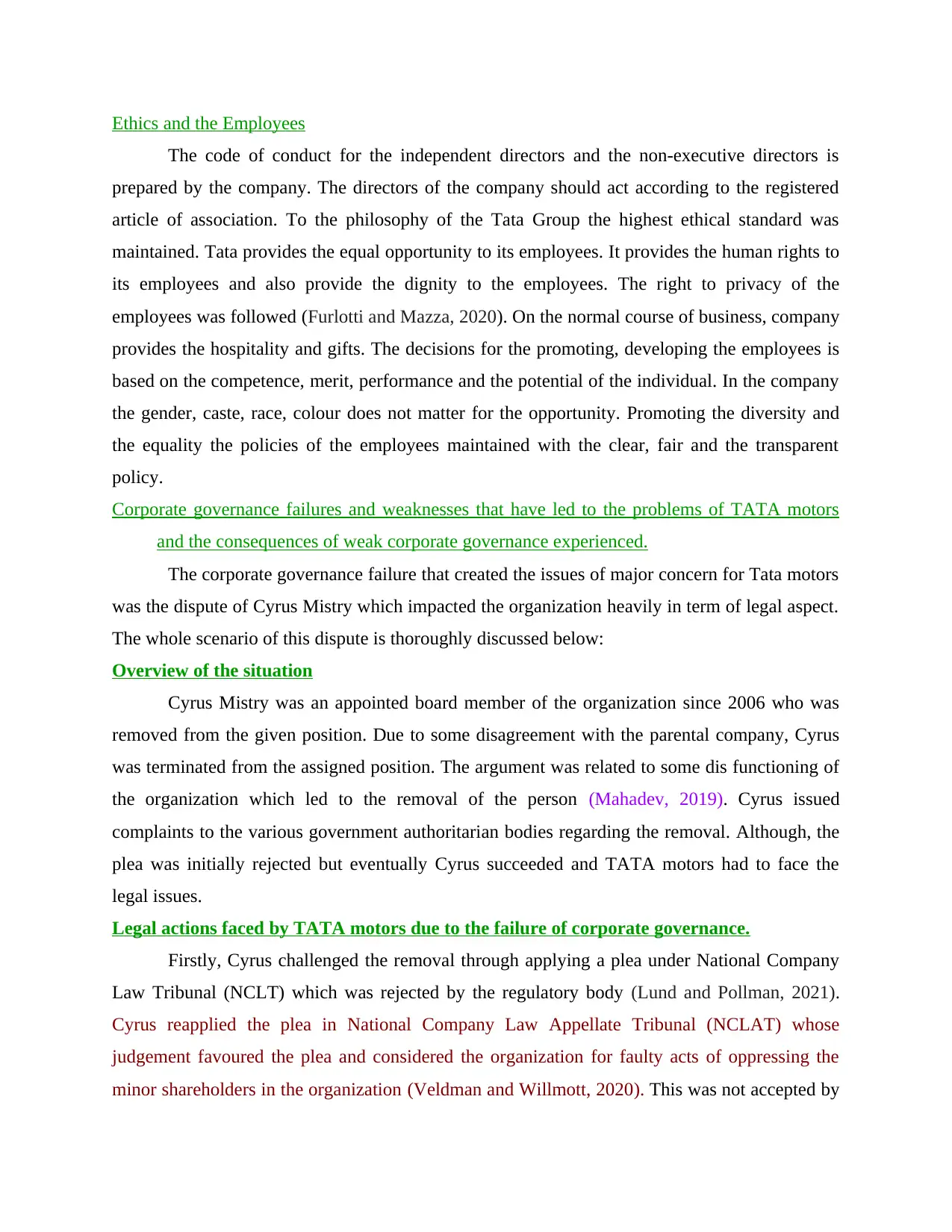
Ethics and the Employees
The code of conduct for the independent directors and the non-executive directors is
prepared by the company. The directors of the company should act according to the registered
article of association. To the philosophy of the Tata Group the highest ethical standard was
maintained. Tata provides the equal opportunity to its employees. It provides the human rights to
its employees and also provide the dignity to the employees. The right to privacy of the
employees was followed (Furlotti and Mazza, 2020). On the normal course of business, company
provides the hospitality and gifts. The decisions for the promoting, developing the employees is
based on the competence, merit, performance and the potential of the individual. In the company
the gender, caste, race, colour does not matter for the opportunity. Promoting the diversity and
the equality the policies of the employees maintained with the clear, fair and the transparent
policy.
Corporate governance failures and weaknesses that have led to the problems of TATA motors
and the consequences of weak corporate governance experienced.
The corporate governance failure that created the issues of major concern for Tata motors
was the dispute of Cyrus Mistry which impacted the organization heavily in term of legal aspect.
The whole scenario of this dispute is thoroughly discussed below:
Overview of the situation
Cyrus Mistry was an appointed board member of the organization since 2006 who was
removed from the given position. Due to some disagreement with the parental company, Cyrus
was terminated from the assigned position. The argument was related to some dis functioning of
the organization which led to the removal of the person (Mahadev, 2019). Cyrus issued
complaints to the various government authoritarian bodies regarding the removal. Although, the
plea was initially rejected but eventually Cyrus succeeded and TATA motors had to face the
legal issues.
Legal actions faced by TATA motors due to the failure of corporate governance.
Firstly, Cyrus challenged the removal through applying a plea under National Company
Law Tribunal (NCLT) which was rejected by the regulatory body (Lund and Pollman, 2021).
Cyrus reapplied the plea in National Company Law Appellate Tribunal (NCLAT) whose
judgement favoured the plea and considered the organization for faulty acts of oppressing the
minor shareholders in the organization (Veldman and Willmott, 2020). This was not accepted by
The code of conduct for the independent directors and the non-executive directors is
prepared by the company. The directors of the company should act according to the registered
article of association. To the philosophy of the Tata Group the highest ethical standard was
maintained. Tata provides the equal opportunity to its employees. It provides the human rights to
its employees and also provide the dignity to the employees. The right to privacy of the
employees was followed (Furlotti and Mazza, 2020). On the normal course of business, company
provides the hospitality and gifts. The decisions for the promoting, developing the employees is
based on the competence, merit, performance and the potential of the individual. In the company
the gender, caste, race, colour does not matter for the opportunity. Promoting the diversity and
the equality the policies of the employees maintained with the clear, fair and the transparent
policy.
Corporate governance failures and weaknesses that have led to the problems of TATA motors
and the consequences of weak corporate governance experienced.
The corporate governance failure that created the issues of major concern for Tata motors
was the dispute of Cyrus Mistry which impacted the organization heavily in term of legal aspect.
The whole scenario of this dispute is thoroughly discussed below:
Overview of the situation
Cyrus Mistry was an appointed board member of the organization since 2006 who was
removed from the given position. Due to some disagreement with the parental company, Cyrus
was terminated from the assigned position. The argument was related to some dis functioning of
the organization which led to the removal of the person (Mahadev, 2019). Cyrus issued
complaints to the various government authoritarian bodies regarding the removal. Although, the
plea was initially rejected but eventually Cyrus succeeded and TATA motors had to face the
legal issues.
Legal actions faced by TATA motors due to the failure of corporate governance.
Firstly, Cyrus challenged the removal through applying a plea under National Company
Law Tribunal (NCLT) which was rejected by the regulatory body (Lund and Pollman, 2021).
Cyrus reapplied the plea in National Company Law Appellate Tribunal (NCLAT) whose
judgement favoured the plea and considered the organization for faulty acts of oppressing the
minor shareholders in the organization (Veldman and Willmott, 2020). This was not accepted by
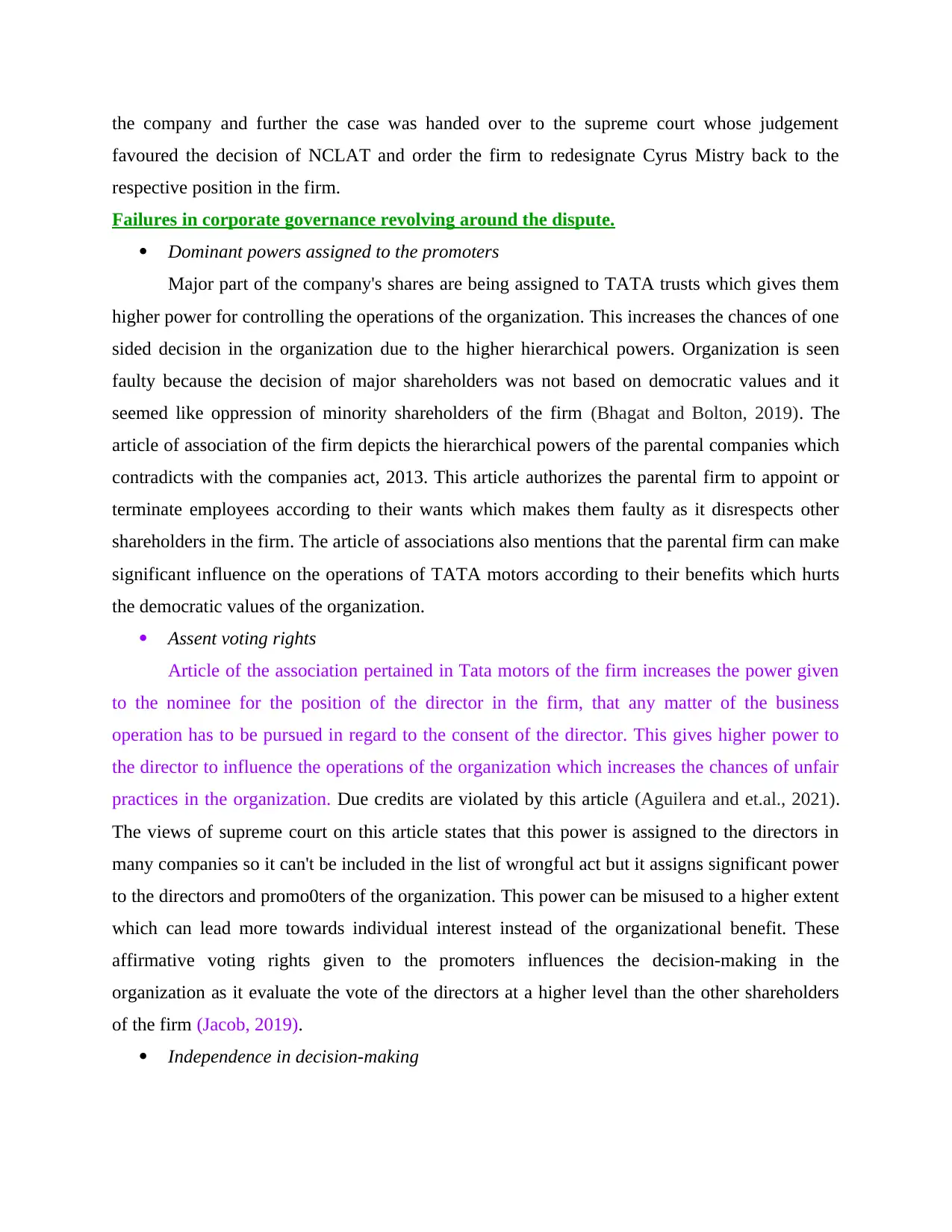
the company and further the case was handed over to the supreme court whose judgement
favoured the decision of NCLAT and order the firm to redesignate Cyrus Mistry back to the
respective position in the firm.
Failures in corporate governance revolving around the dispute.
Dominant powers assigned to the promoters
Major part of the company's shares are being assigned to TATA trusts which gives them
higher power for controlling the operations of the organization. This increases the chances of one
sided decision in the organization due to the higher hierarchical powers. Organization is seen
faulty because the decision of major shareholders was not based on democratic values and it
seemed like oppression of minority shareholders of the firm (Bhagat and Bolton, 2019). The
article of association of the firm depicts the hierarchical powers of the parental companies which
contradicts with the companies act, 2013. This article authorizes the parental firm to appoint or
terminate employees according to their wants which makes them faulty as it disrespects other
shareholders in the firm. The article of associations also mentions that the parental firm can make
significant influence on the operations of TATA motors according to their benefits which hurts
the democratic values of the organization.
Assent voting rights
Article of the association pertained in Tata motors of the firm increases the power given
to the nominee for the position of the director in the firm, that any matter of the business
operation has to be pursued in regard to the consent of the director. This gives higher power to
the director to influence the operations of the organization which increases the chances of unfair
practices in the organization. Due credits are violated by this article (Aguilera and et.al., 2021).
The views of supreme court on this article states that this power is assigned to the directors in
many companies so it can't be included in the list of wrongful act but it assigns significant power
to the directors and promo0ters of the organization. This power can be misused to a higher extent
which can lead more towards individual interest instead of the organizational benefit. These
affirmative voting rights given to the promoters influences the decision-making in the
organization as it evaluate the vote of the directors at a higher level than the other shareholders
of the firm (Jacob, 2019).
Independence in decision-making
favoured the decision of NCLAT and order the firm to redesignate Cyrus Mistry back to the
respective position in the firm.
Failures in corporate governance revolving around the dispute.
Dominant powers assigned to the promoters
Major part of the company's shares are being assigned to TATA trusts which gives them
higher power for controlling the operations of the organization. This increases the chances of one
sided decision in the organization due to the higher hierarchical powers. Organization is seen
faulty because the decision of major shareholders was not based on democratic values and it
seemed like oppression of minority shareholders of the firm (Bhagat and Bolton, 2019). The
article of association of the firm depicts the hierarchical powers of the parental companies which
contradicts with the companies act, 2013. This article authorizes the parental firm to appoint or
terminate employees according to their wants which makes them faulty as it disrespects other
shareholders in the firm. The article of associations also mentions that the parental firm can make
significant influence on the operations of TATA motors according to their benefits which hurts
the democratic values of the organization.
Assent voting rights
Article of the association pertained in Tata motors of the firm increases the power given
to the nominee for the position of the director in the firm, that any matter of the business
operation has to be pursued in regard to the consent of the director. This gives higher power to
the director to influence the operations of the organization which increases the chances of unfair
practices in the organization. Due credits are violated by this article (Aguilera and et.al., 2021).
The views of supreme court on this article states that this power is assigned to the directors in
many companies so it can't be included in the list of wrongful act but it assigns significant power
to the directors and promo0ters of the organization. This power can be misused to a higher extent
which can lead more towards individual interest instead of the organizational benefit. These
affirmative voting rights given to the promoters influences the decision-making in the
organization as it evaluate the vote of the directors at a higher level than the other shareholders
of the firm (Jacob, 2019).
Independence in decision-making
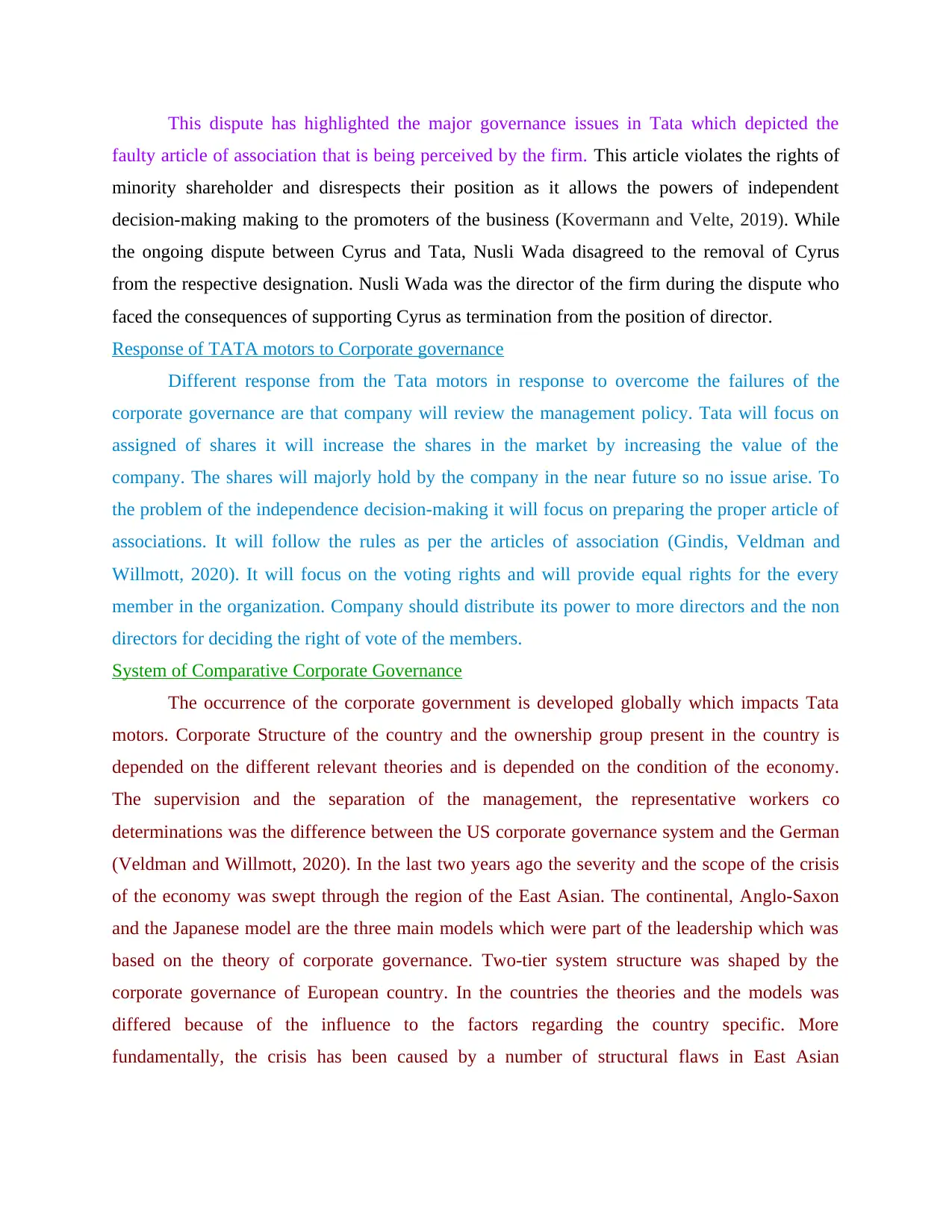
This dispute has highlighted the major governance issues in Tata which depicted the
faulty article of association that is being perceived by the firm. This article violates the rights of
minority shareholder and disrespects their position as it allows the powers of independent
decision-making making to the promoters of the business (Kovermann and Velte, 2019). While
the ongoing dispute between Cyrus and Tata, Nusli Wada disagreed to the removal of Cyrus
from the respective designation. Nusli Wada was the director of the firm during the dispute who
faced the consequences of supporting Cyrus as termination from the position of director.
Response of TATA motors to Corporate governance
Different response from the Tata motors in response to overcome the failures of the
corporate governance are that company will review the management policy. Tata will focus on
assigned of shares it will increase the shares in the market by increasing the value of the
company. The shares will majorly hold by the company in the near future so no issue arise. To
the problem of the independence decision-making it will focus on preparing the proper article of
associations. It will follow the rules as per the articles of association (Gindis, Veldman and
Willmott, 2020). It will focus on the voting rights and will provide equal rights for the every
member in the organization. Company should distribute its power to more directors and the non
directors for deciding the right of vote of the members.
System of Comparative Corporate Governance
The occurrence of the corporate government is developed globally which impacts Tata
motors. Corporate Structure of the country and the ownership group present in the country is
depended on the different relevant theories and is depended on the condition of the economy.
The supervision and the separation of the management, the representative workers co
determinations was the difference between the US corporate governance system and the German
(Veldman and Willmott, 2020). In the last two years ago the severity and the scope of the crisis
of the economy was swept through the region of the East Asian. The continental, Anglo-Saxon
and the Japanese model are the three main models which were part of the leadership which was
based on the theory of corporate governance. Two-tier system structure was shaped by the
corporate governance of European country. In the countries the theories and the models was
differed because of the influence to the factors regarding the country specific. More
fundamentally, the crisis has been caused by a number of structural flaws in East Asian
faulty article of association that is being perceived by the firm. This article violates the rights of
minority shareholder and disrespects their position as it allows the powers of independent
decision-making making to the promoters of the business (Kovermann and Velte, 2019). While
the ongoing dispute between Cyrus and Tata, Nusli Wada disagreed to the removal of Cyrus
from the respective designation. Nusli Wada was the director of the firm during the dispute who
faced the consequences of supporting Cyrus as termination from the position of director.
Response of TATA motors to Corporate governance
Different response from the Tata motors in response to overcome the failures of the
corporate governance are that company will review the management policy. Tata will focus on
assigned of shares it will increase the shares in the market by increasing the value of the
company. The shares will majorly hold by the company in the near future so no issue arise. To
the problem of the independence decision-making it will focus on preparing the proper article of
associations. It will follow the rules as per the articles of association (Gindis, Veldman and
Willmott, 2020). It will focus on the voting rights and will provide equal rights for the every
member in the organization. Company should distribute its power to more directors and the non
directors for deciding the right of vote of the members.
System of Comparative Corporate Governance
The occurrence of the corporate government is developed globally which impacts Tata
motors. Corporate Structure of the country and the ownership group present in the country is
depended on the different relevant theories and is depended on the condition of the economy.
The supervision and the separation of the management, the representative workers co
determinations was the difference between the US corporate governance system and the German
(Veldman and Willmott, 2020). In the last two years ago the severity and the scope of the crisis
of the economy was swept through the region of the East Asian. The continental, Anglo-Saxon
and the Japanese model are the three main models which were part of the leadership which was
based on the theory of corporate governance. Two-tier system structure was shaped by the
corporate governance of European country. In the countries the theories and the models was
differed because of the influence to the factors regarding the country specific. More
fundamentally, the crisis has been caused by a number of structural flaws in East Asian
Paraphrase This Document
Need a fresh take? Get an instant paraphrase of this document with our AI Paraphraser
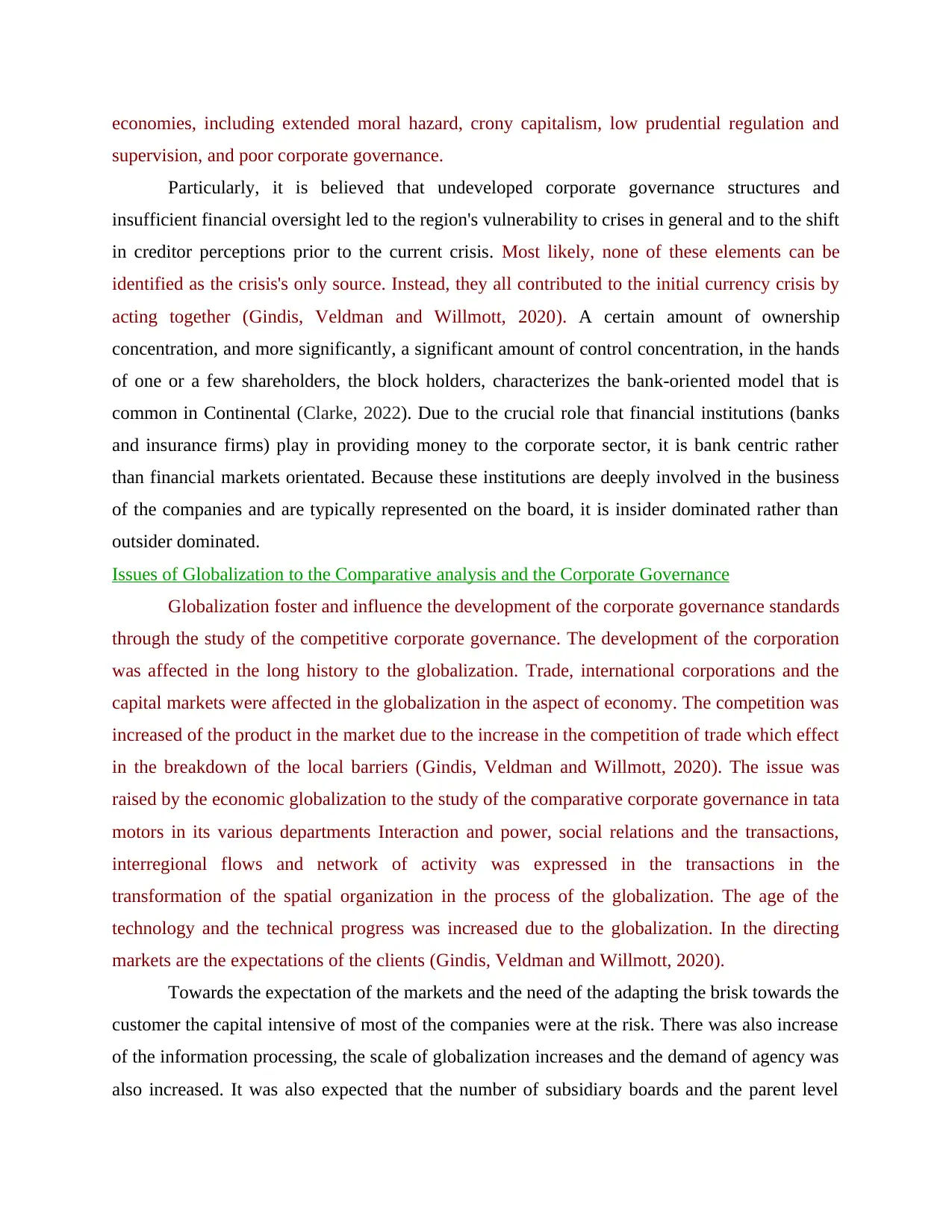
economies, including extended moral hazard, crony capitalism, low prudential regulation and
supervision, and poor corporate governance.
Particularly, it is believed that undeveloped corporate governance structures and
insufficient financial oversight led to the region's vulnerability to crises in general and to the shift
in creditor perceptions prior to the current crisis. Most likely, none of these elements can be
identified as the crisis's only source. Instead, they all contributed to the initial currency crisis by
acting together (Gindis, Veldman and Willmott, 2020). A certain amount of ownership
concentration, and more significantly, a significant amount of control concentration, in the hands
of one or a few shareholders, the block holders, characterizes the bank-oriented model that is
common in Continental (Clarke, 2022). Due to the crucial role that financial institutions (banks
and insurance firms) play in providing money to the corporate sector, it is bank centric rather
than financial markets orientated. Because these institutions are deeply involved in the business
of the companies and are typically represented on the board, it is insider dominated rather than
outsider dominated.
Issues of Globalization to the Comparative analysis and the Corporate Governance
Globalization foster and influence the development of the corporate governance standards
through the study of the competitive corporate governance. The development of the corporation
was affected in the long history to the globalization. Trade, international corporations and the
capital markets were affected in the globalization in the aspect of economy. The competition was
increased of the product in the market due to the increase in the competition of trade which effect
in the breakdown of the local barriers (Gindis, Veldman and Willmott, 2020). The issue was
raised by the economic globalization to the study of the comparative corporate governance in tata
motors in its various departments Interaction and power, social relations and the transactions,
interregional flows and network of activity was expressed in the transactions in the
transformation of the spatial organization in the process of the globalization. The age of the
technology and the technical progress was increased due to the globalization. In the directing
markets are the expectations of the clients (Gindis, Veldman and Willmott, 2020).
Towards the expectation of the markets and the need of the adapting the brisk towards the
customer the capital intensive of most of the companies were at the risk. There was also increase
of the information processing, the scale of globalization increases and the demand of agency was
also increased. It was also expected that the number of subsidiary boards and the parent level
supervision, and poor corporate governance.
Particularly, it is believed that undeveloped corporate governance structures and
insufficient financial oversight led to the region's vulnerability to crises in general and to the shift
in creditor perceptions prior to the current crisis. Most likely, none of these elements can be
identified as the crisis's only source. Instead, they all contributed to the initial currency crisis by
acting together (Gindis, Veldman and Willmott, 2020). A certain amount of ownership
concentration, and more significantly, a significant amount of control concentration, in the hands
of one or a few shareholders, the block holders, characterizes the bank-oriented model that is
common in Continental (Clarke, 2022). Due to the crucial role that financial institutions (banks
and insurance firms) play in providing money to the corporate sector, it is bank centric rather
than financial markets orientated. Because these institutions are deeply involved in the business
of the companies and are typically represented on the board, it is insider dominated rather than
outsider dominated.
Issues of Globalization to the Comparative analysis and the Corporate Governance
Globalization foster and influence the development of the corporate governance standards
through the study of the competitive corporate governance. The development of the corporation
was affected in the long history to the globalization. Trade, international corporations and the
capital markets were affected in the globalization in the aspect of economy. The competition was
increased of the product in the market due to the increase in the competition of trade which effect
in the breakdown of the local barriers (Gindis, Veldman and Willmott, 2020). The issue was
raised by the economic globalization to the study of the comparative corporate governance in tata
motors in its various departments Interaction and power, social relations and the transactions,
interregional flows and network of activity was expressed in the transactions in the
transformation of the spatial organization in the process of the globalization. The age of the
technology and the technical progress was increased due to the globalization. In the directing
markets are the expectations of the clients (Gindis, Veldman and Willmott, 2020).
Towards the expectation of the markets and the need of the adapting the brisk towards the
customer the capital intensive of most of the companies were at the risk. There was also increase
of the information processing, the scale of globalization increases and the demand of agency was
also increased. It was also expected that the number of subsidiary boards and the parent level
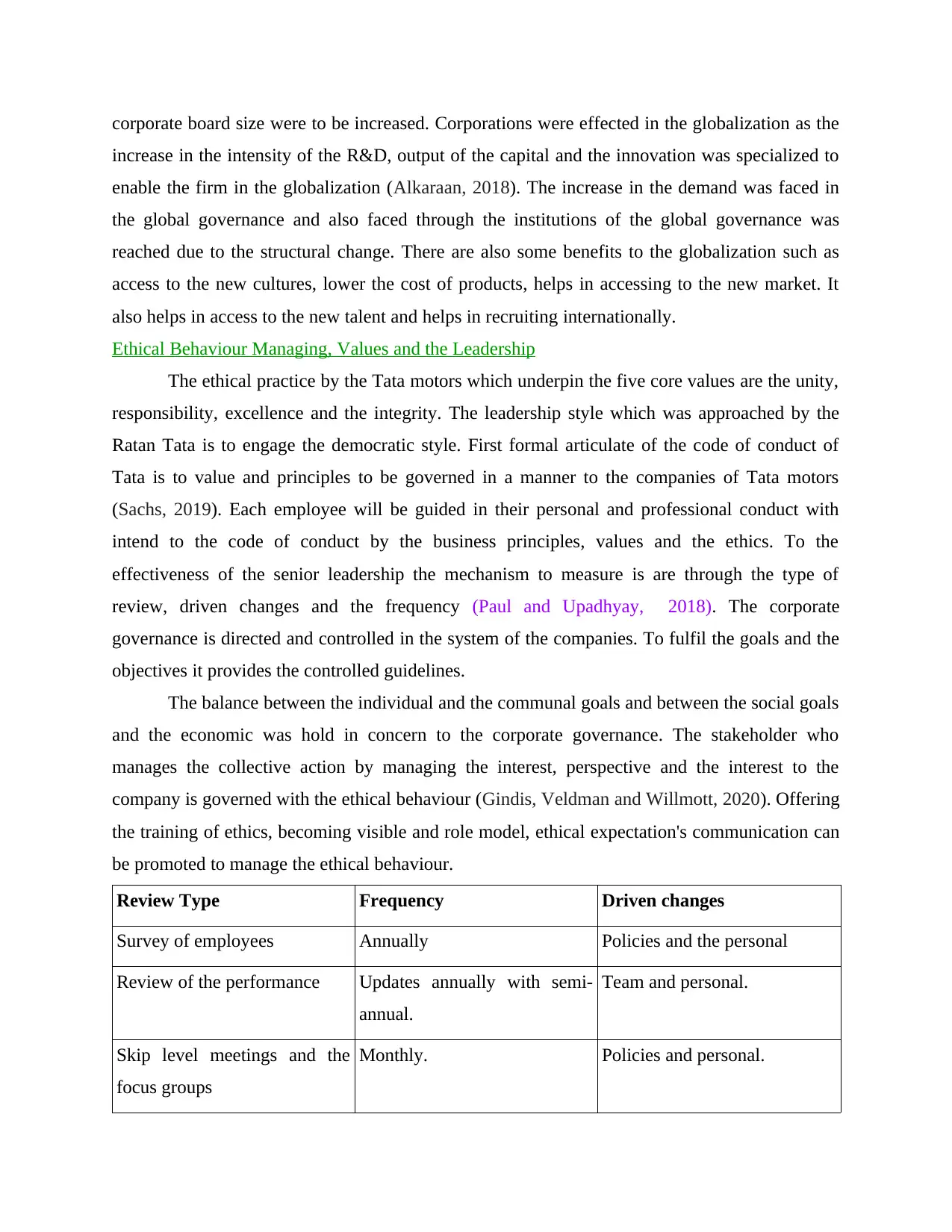
corporate board size were to be increased. Corporations were effected in the globalization as the
increase in the intensity of the R&D, output of the capital and the innovation was specialized to
enable the firm in the globalization (Alkaraan, 2018). The increase in the demand was faced in
the global governance and also faced through the institutions of the global governance was
reached due to the structural change. There are also some benefits to the globalization such as
access to the new cultures, lower the cost of products, helps in accessing to the new market. It
also helps in access to the new talent and helps in recruiting internationally.
Ethical Behaviour Managing, Values and the Leadership
The ethical practice by the Tata motors which underpin the five core values are the unity,
responsibility, excellence and the integrity. The leadership style which was approached by the
Ratan Tata is to engage the democratic style. First formal articulate of the code of conduct of
Tata is to value and principles to be governed in a manner to the companies of Tata motors
(Sachs, 2019). Each employee will be guided in their personal and professional conduct with
intend to the code of conduct by the business principles, values and the ethics. To the
effectiveness of the senior leadership the mechanism to measure is are through the type of
review, driven changes and the frequency (Paul and Upadhyay, 2018). The corporate
governance is directed and controlled in the system of the companies. To fulfil the goals and the
objectives it provides the controlled guidelines.
The balance between the individual and the communal goals and between the social goals
and the economic was hold in concern to the corporate governance. The stakeholder who
manages the collective action by managing the interest, perspective and the interest to the
company is governed with the ethical behaviour (Gindis, Veldman and Willmott, 2020). Offering
the training of ethics, becoming visible and role model, ethical expectation's communication can
be promoted to manage the ethical behaviour.
Review Type Frequency Driven changes
Survey of employees Annually Policies and the personal
Review of the performance Updates annually with semi-
annual.
Team and personal.
Skip level meetings and the
focus groups
Monthly. Policies and personal.
increase in the intensity of the R&D, output of the capital and the innovation was specialized to
enable the firm in the globalization (Alkaraan, 2018). The increase in the demand was faced in
the global governance and also faced through the institutions of the global governance was
reached due to the structural change. There are also some benefits to the globalization such as
access to the new cultures, lower the cost of products, helps in accessing to the new market. It
also helps in access to the new talent and helps in recruiting internationally.
Ethical Behaviour Managing, Values and the Leadership
The ethical practice by the Tata motors which underpin the five core values are the unity,
responsibility, excellence and the integrity. The leadership style which was approached by the
Ratan Tata is to engage the democratic style. First formal articulate of the code of conduct of
Tata is to value and principles to be governed in a manner to the companies of Tata motors
(Sachs, 2019). Each employee will be guided in their personal and professional conduct with
intend to the code of conduct by the business principles, values and the ethics. To the
effectiveness of the senior leadership the mechanism to measure is are through the type of
review, driven changes and the frequency (Paul and Upadhyay, 2018). The corporate
governance is directed and controlled in the system of the companies. To fulfil the goals and the
objectives it provides the controlled guidelines.
The balance between the individual and the communal goals and between the social goals
and the economic was hold in concern to the corporate governance. The stakeholder who
manages the collective action by managing the interest, perspective and the interest to the
company is governed with the ethical behaviour (Gindis, Veldman and Willmott, 2020). Offering
the training of ethics, becoming visible and role model, ethical expectation's communication can
be promoted to manage the ethical behaviour.
Review Type Frequency Driven changes
Survey of employees Annually Policies and the personal
Review of the performance Updates annually with semi-
annual.
Team and personal.
Skip level meetings and the
focus groups
Monthly. Policies and personal.
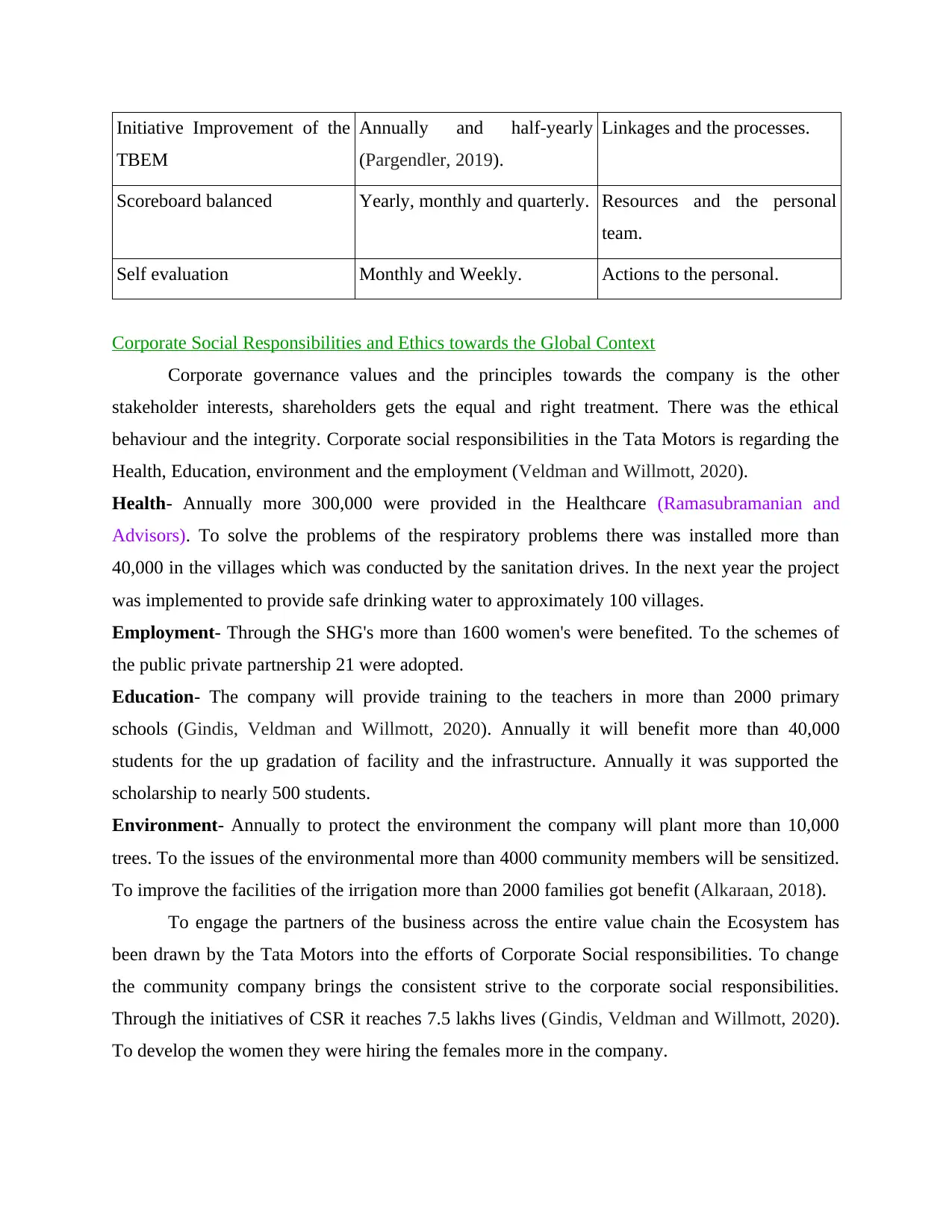
Initiative Improvement of the
TBEM
Annually and half-yearly
(Pargendler, 2019).
Linkages and the processes.
Scoreboard balanced Yearly, monthly and quarterly. Resources and the personal
team.
Self evaluation Monthly and Weekly. Actions to the personal.
Corporate Social Responsibilities and Ethics towards the Global Context
Corporate governance values and the principles towards the company is the other
stakeholder interests, shareholders gets the equal and right treatment. There was the ethical
behaviour and the integrity. Corporate social responsibilities in the Tata Motors is regarding the
Health, Education, environment and the employment (Veldman and Willmott, 2020).
Health- Annually more 300,000 were provided in the Healthcare (Ramasubramanian and
Advisors). To solve the problems of the respiratory problems there was installed more than
40,000 in the villages which was conducted by the sanitation drives. In the next year the project
was implemented to provide safe drinking water to approximately 100 villages.
Employment- Through the SHG's more than 1600 women's were benefited. To the schemes of
the public private partnership 21 were adopted.
Education- The company will provide training to the teachers in more than 2000 primary
schools (Gindis, Veldman and Willmott, 2020). Annually it will benefit more than 40,000
students for the up gradation of facility and the infrastructure. Annually it was supported the
scholarship to nearly 500 students.
Environment- Annually to protect the environment the company will plant more than 10,000
trees. To the issues of the environmental more than 4000 community members will be sensitized.
To improve the facilities of the irrigation more than 2000 families got benefit (Alkaraan, 2018).
To engage the partners of the business across the entire value chain the Ecosystem has
been drawn by the Tata Motors into the efforts of Corporate Social responsibilities. To change
the community company brings the consistent strive to the corporate social responsibilities.
Through the initiatives of CSR it reaches 7.5 lakhs lives (Gindis, Veldman and Willmott, 2020).
To develop the women they were hiring the females more in the company.
TBEM
Annually and half-yearly
(Pargendler, 2019).
Linkages and the processes.
Scoreboard balanced Yearly, monthly and quarterly. Resources and the personal
team.
Self evaluation Monthly and Weekly. Actions to the personal.
Corporate Social Responsibilities and Ethics towards the Global Context
Corporate governance values and the principles towards the company is the other
stakeholder interests, shareholders gets the equal and right treatment. There was the ethical
behaviour and the integrity. Corporate social responsibilities in the Tata Motors is regarding the
Health, Education, environment and the employment (Veldman and Willmott, 2020).
Health- Annually more 300,000 were provided in the Healthcare (Ramasubramanian and
Advisors). To solve the problems of the respiratory problems there was installed more than
40,000 in the villages which was conducted by the sanitation drives. In the next year the project
was implemented to provide safe drinking water to approximately 100 villages.
Employment- Through the SHG's more than 1600 women's were benefited. To the schemes of
the public private partnership 21 were adopted.
Education- The company will provide training to the teachers in more than 2000 primary
schools (Gindis, Veldman and Willmott, 2020). Annually it will benefit more than 40,000
students for the up gradation of facility and the infrastructure. Annually it was supported the
scholarship to nearly 500 students.
Environment- Annually to protect the environment the company will plant more than 10,000
trees. To the issues of the environmental more than 4000 community members will be sensitized.
To improve the facilities of the irrigation more than 2000 families got benefit (Alkaraan, 2018).
To engage the partners of the business across the entire value chain the Ecosystem has
been drawn by the Tata Motors into the efforts of Corporate Social responsibilities. To change
the community company brings the consistent strive to the corporate social responsibilities.
Through the initiatives of CSR it reaches 7.5 lakhs lives (Gindis, Veldman and Willmott, 2020).
To develop the women they were hiring the females more in the company.
Secure Best Marks with AI Grader
Need help grading? Try our AI Grader for instant feedback on your assignments.
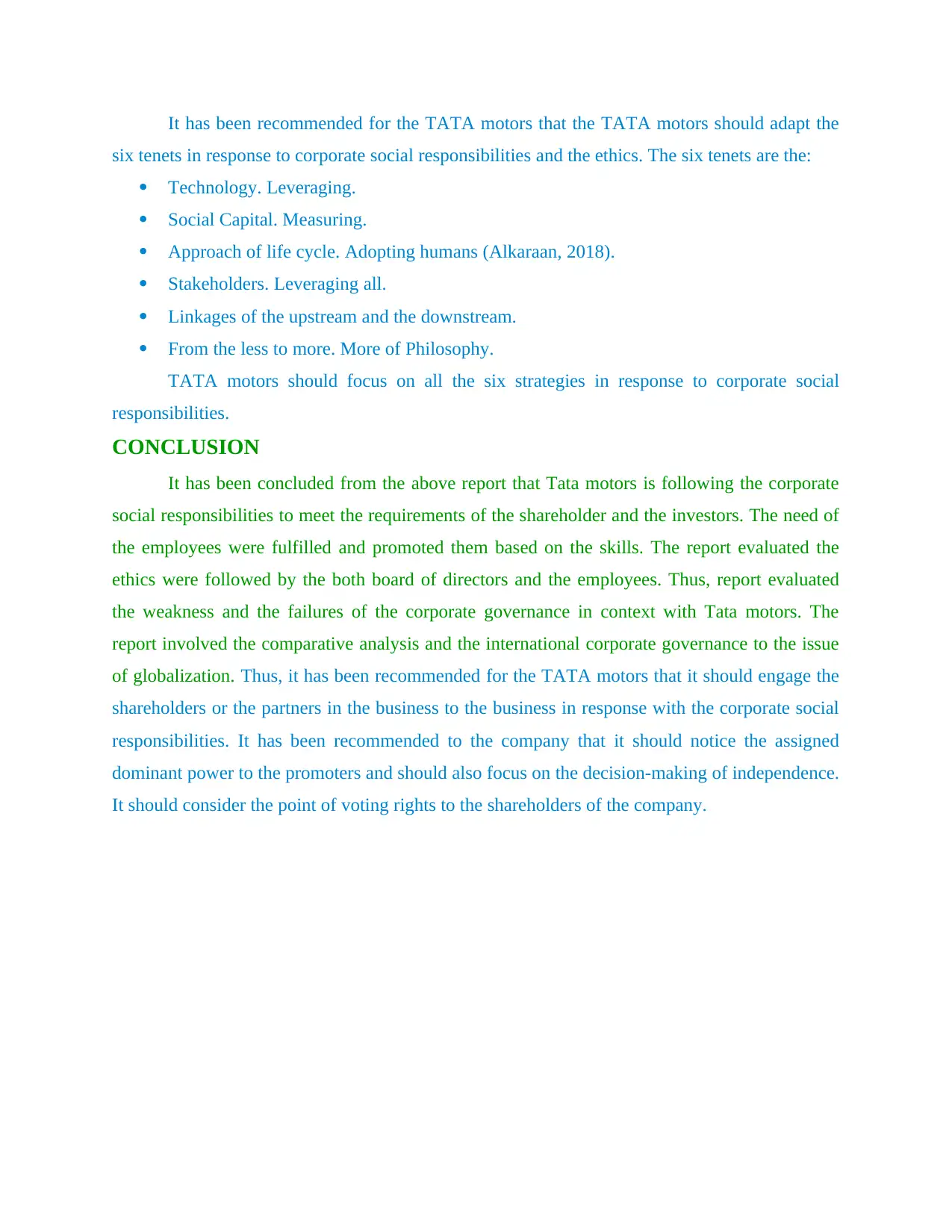
It has been recommended for the TATA motors that the TATA motors should adapt the
six tenets in response to corporate social responsibilities and the ethics. The six tenets are the:
Technology. Leveraging.
Social Capital. Measuring.
Approach of life cycle. Adopting humans (Alkaraan, 2018).
Stakeholders. Leveraging all.
Linkages of the upstream and the downstream.
From the less to more. More of Philosophy.
TATA motors should focus on all the six strategies in response to corporate social
responsibilities.
CONCLUSION
It has been concluded from the above report that Tata motors is following the corporate
social responsibilities to meet the requirements of the shareholder and the investors. The need of
the employees were fulfilled and promoted them based on the skills. The report evaluated the
ethics were followed by the both board of directors and the employees. Thus, report evaluated
the weakness and the failures of the corporate governance in context with Tata motors. The
report involved the comparative analysis and the international corporate governance to the issue
of globalization. Thus, it has been recommended for the TATA motors that it should engage the
shareholders or the partners in the business to the business in response with the corporate social
responsibilities. It has been recommended to the company that it should notice the assigned
dominant power to the promoters and should also focus on the decision-making of independence.
It should consider the point of voting rights to the shareholders of the company.
six tenets in response to corporate social responsibilities and the ethics. The six tenets are the:
Technology. Leveraging.
Social Capital. Measuring.
Approach of life cycle. Adopting humans (Alkaraan, 2018).
Stakeholders. Leveraging all.
Linkages of the upstream and the downstream.
From the less to more. More of Philosophy.
TATA motors should focus on all the six strategies in response to corporate social
responsibilities.
CONCLUSION
It has been concluded from the above report that Tata motors is following the corporate
social responsibilities to meet the requirements of the shareholder and the investors. The need of
the employees were fulfilled and promoted them based on the skills. The report evaluated the
ethics were followed by the both board of directors and the employees. Thus, report evaluated
the weakness and the failures of the corporate governance in context with Tata motors. The
report involved the comparative analysis and the international corporate governance to the issue
of globalization. Thus, it has been recommended for the TATA motors that it should engage the
shareholders or the partners in the business to the business in response with the corporate social
responsibilities. It has been recommended to the company that it should notice the assigned
dominant power to the promoters and should also focus on the decision-making of independence.
It should consider the point of voting rights to the shareholders of the company.
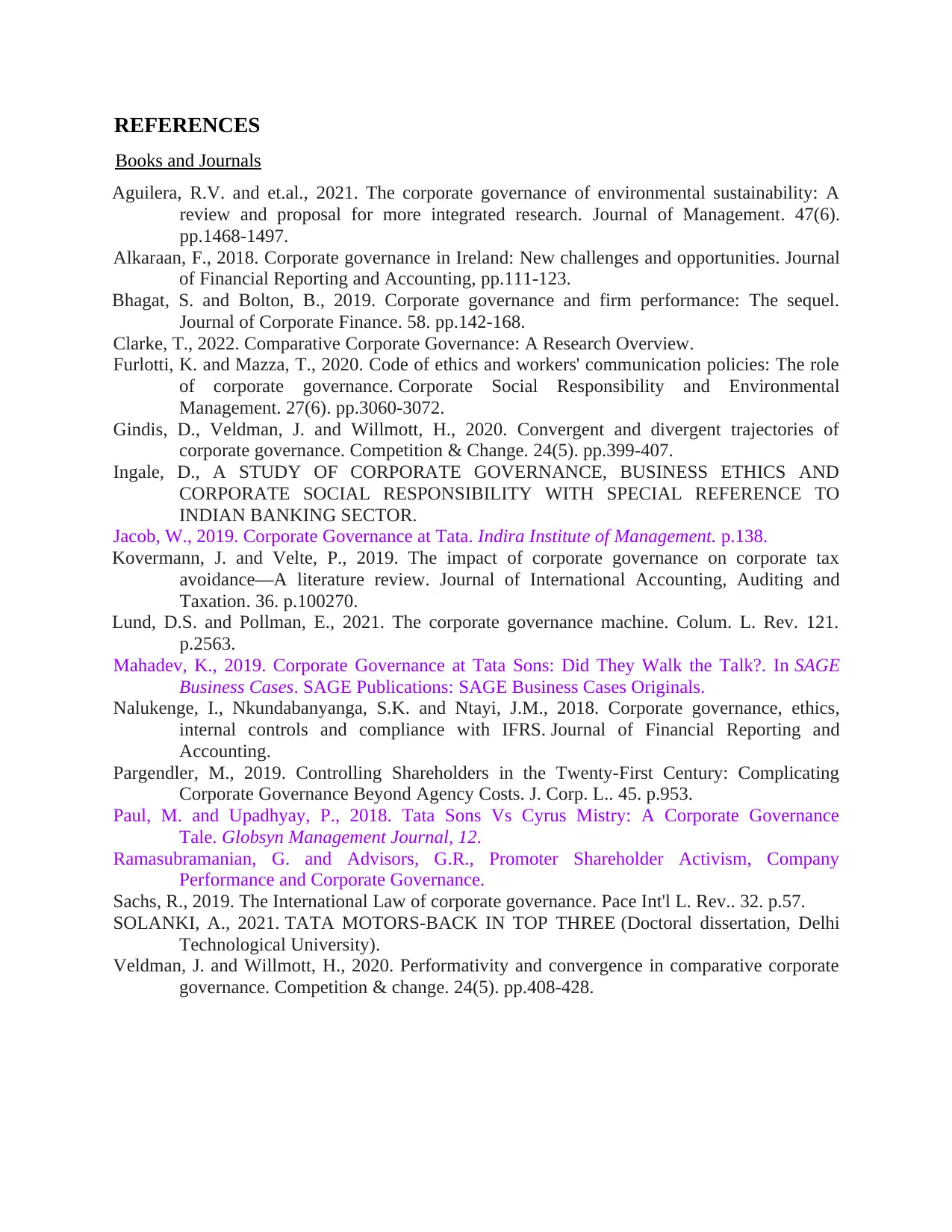
REFERENCES
Books and Journals
Aguilera, R.V. and et.al., 2021. The corporate governance of environmental sustainability: A
review and proposal for more integrated research. Journal of Management. 47(6).
pp.1468-1497.
Alkaraan, F., 2018. Corporate governance in Ireland: New challenges and opportunities. Journal
of Financial Reporting and Accounting, pp.111-123.
Bhagat, S. and Bolton, B., 2019. Corporate governance and firm performance: The sequel.
Journal of Corporate Finance. 58. pp.142-168.
Clarke, T., 2022. Comparative Corporate Governance: A Research Overview.
Furlotti, K. and Mazza, T., 2020. Code of ethics and workers' communication policies: The role
of corporate governance. Corporate Social Responsibility and Environmental
Management. 27(6). pp.3060-3072.
Gindis, D., Veldman, J. and Willmott, H., 2020. Convergent and divergent trajectories of
corporate governance. Competition & Change. 24(5). pp.399-407.
Ingale, D., A STUDY OF CORPORATE GOVERNANCE, BUSINESS ETHICS AND
CORPORATE SOCIAL RESPONSIBILITY WITH SPECIAL REFERENCE TO
INDIAN BANKING SECTOR.
Jacob, W., 2019. Corporate Governance at Tata. Indira Institute of Management. p.138.
Kovermann, J. and Velte, P., 2019. The impact of corporate governance on corporate tax
avoidance—A literature review. Journal of International Accounting, Auditing and
Taxation. 36. p.100270.
Lund, D.S. and Pollman, E., 2021. The corporate governance machine. Colum. L. Rev. 121.
p.2563.
Mahadev, K., 2019. Corporate Governance at Tata Sons: Did They Walk the Talk?. In SAGE
Business Cases. SAGE Publications: SAGE Business Cases Originals.
Nalukenge, I., Nkundabanyanga, S.K. and Ntayi, J.M., 2018. Corporate governance, ethics,
internal controls and compliance with IFRS. Journal of Financial Reporting and
Accounting.
Pargendler, M., 2019. Controlling Shareholders in the Twenty-First Century: Complicating
Corporate Governance Beyond Agency Costs. J. Corp. L.. 45. p.953.
Paul, M. and Upadhyay, P., 2018. Tata Sons Vs Cyrus Mistry: A Corporate Governance
Tale. Globsyn Management Journal, 12.
Ramasubramanian, G. and Advisors, G.R., Promoter Shareholder Activism, Company
Performance and Corporate Governance.
Sachs, R., 2019. The International Law of corporate governance. Pace Int'l L. Rev.. 32. p.57.
SOLANKI, A., 2021. TATA MOTORS-BACK IN TOP THREE (Doctoral dissertation, Delhi
Technological University).
Veldman, J. and Willmott, H., 2020. Performativity and convergence in comparative corporate
governance. Competition & change. 24(5). pp.408-428.
Books and Journals
Aguilera, R.V. and et.al., 2021. The corporate governance of environmental sustainability: A
review and proposal for more integrated research. Journal of Management. 47(6).
pp.1468-1497.
Alkaraan, F., 2018. Corporate governance in Ireland: New challenges and opportunities. Journal
of Financial Reporting and Accounting, pp.111-123.
Bhagat, S. and Bolton, B., 2019. Corporate governance and firm performance: The sequel.
Journal of Corporate Finance. 58. pp.142-168.
Clarke, T., 2022. Comparative Corporate Governance: A Research Overview.
Furlotti, K. and Mazza, T., 2020. Code of ethics and workers' communication policies: The role
of corporate governance. Corporate Social Responsibility and Environmental
Management. 27(6). pp.3060-3072.
Gindis, D., Veldman, J. and Willmott, H., 2020. Convergent and divergent trajectories of
corporate governance. Competition & Change. 24(5). pp.399-407.
Ingale, D., A STUDY OF CORPORATE GOVERNANCE, BUSINESS ETHICS AND
CORPORATE SOCIAL RESPONSIBILITY WITH SPECIAL REFERENCE TO
INDIAN BANKING SECTOR.
Jacob, W., 2019. Corporate Governance at Tata. Indira Institute of Management. p.138.
Kovermann, J. and Velte, P., 2019. The impact of corporate governance on corporate tax
avoidance—A literature review. Journal of International Accounting, Auditing and
Taxation. 36. p.100270.
Lund, D.S. and Pollman, E., 2021. The corporate governance machine. Colum. L. Rev. 121.
p.2563.
Mahadev, K., 2019. Corporate Governance at Tata Sons: Did They Walk the Talk?. In SAGE
Business Cases. SAGE Publications: SAGE Business Cases Originals.
Nalukenge, I., Nkundabanyanga, S.K. and Ntayi, J.M., 2018. Corporate governance, ethics,
internal controls and compliance with IFRS. Journal of Financial Reporting and
Accounting.
Pargendler, M., 2019. Controlling Shareholders in the Twenty-First Century: Complicating
Corporate Governance Beyond Agency Costs. J. Corp. L.. 45. p.953.
Paul, M. and Upadhyay, P., 2018. Tata Sons Vs Cyrus Mistry: A Corporate Governance
Tale. Globsyn Management Journal, 12.
Ramasubramanian, G. and Advisors, G.R., Promoter Shareholder Activism, Company
Performance and Corporate Governance.
Sachs, R., 2019. The International Law of corporate governance. Pace Int'l L. Rev.. 32. p.57.
SOLANKI, A., 2021. TATA MOTORS-BACK IN TOP THREE (Doctoral dissertation, Delhi
Technological University).
Veldman, J. and Willmott, H., 2020. Performativity and convergence in comparative corporate
governance. Competition & change. 24(5). pp.408-428.
1 out of 12
Related Documents
Your All-in-One AI-Powered Toolkit for Academic Success.
+13062052269
info@desklib.com
Available 24*7 on WhatsApp / Email
![[object Object]](/_next/static/media/star-bottom.7253800d.svg)
Unlock your academic potential
© 2024 | Zucol Services PVT LTD | All rights reserved.





